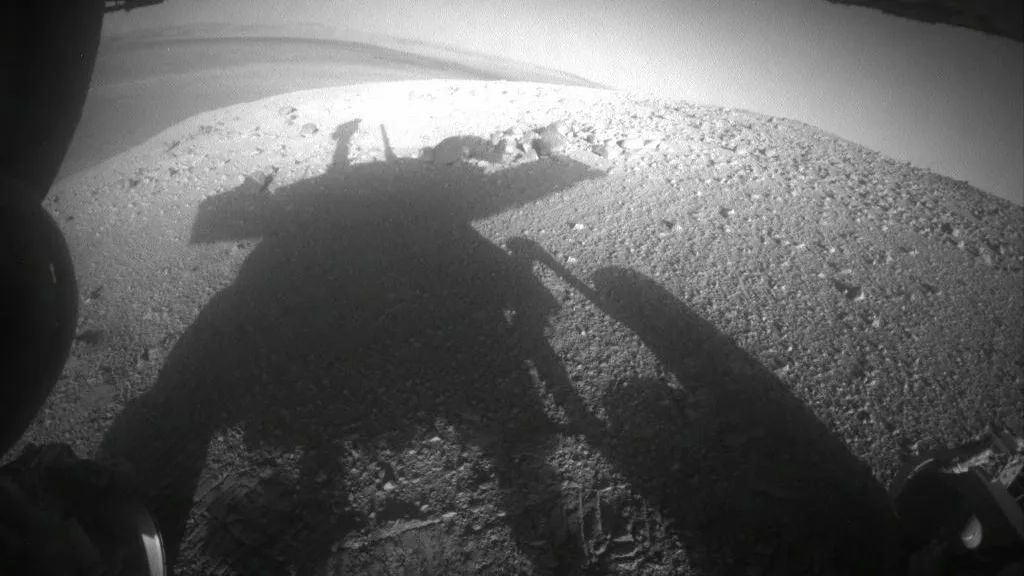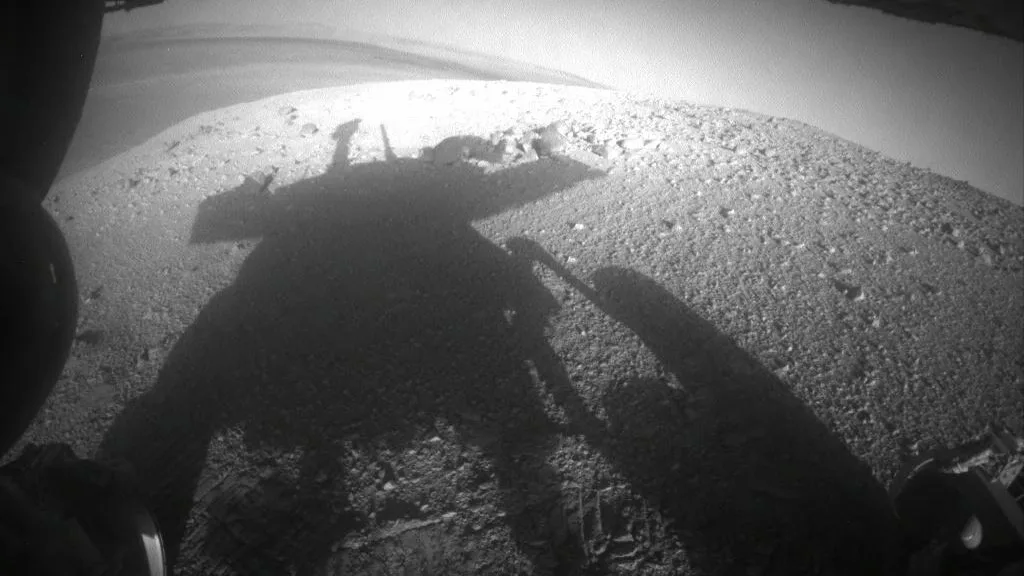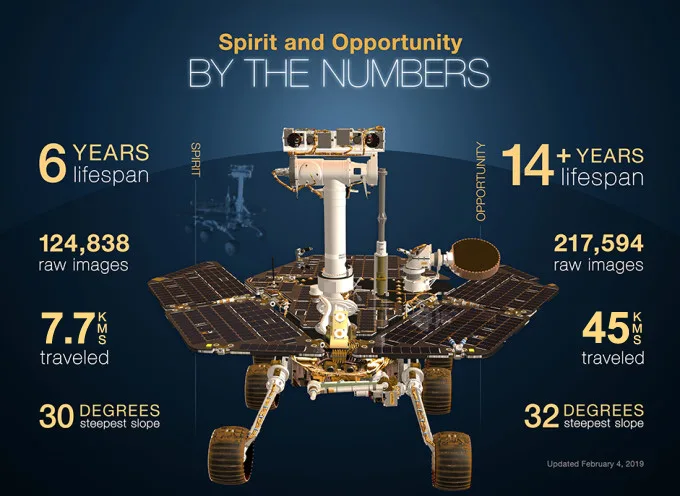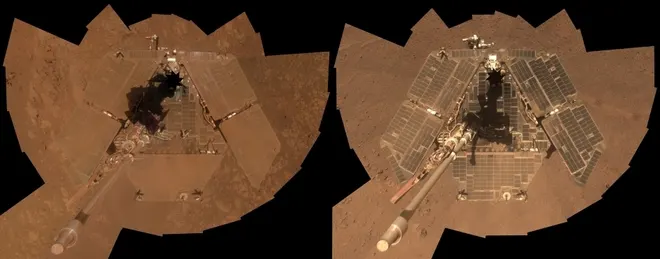
Opportunity lost: NASA officially ends Mars rover mission
Now silent for over 8 months, following an intense global dust storm, the 15-year-long mission of NASA's Opportunity rover has officially come to an end.
On January 25, 2004, a brand new solar-powered robot geologist began roving around on the surface of the Mars.
Mars Exploration Rover Opportunity had just arrived after a six month journey through space, and it wasted no time in setting off on its planned 90-day, 1-kilometre mission to search for signs that Mars was once a much wetter place, which could have hosted life.

A view of Opportunity's shadow against the Martian landscape, taken by the rover's front hazard avoidance camera, looking out between the rover's front wheels, on March 20, 2014. Credit: NASA/JPL-Caltech
Now 15 years later, and having travelled for over 45 kilometres (an off-world driving record!), this veteran rover has finally given up.
At 2 p.m. ET, on Wednesday February 13, 2019, NASA hosted a briefing from the Jet Propulsion Laboratory, in Pasadena, Calif., to officially end Opportunity's mission, and highlight the many accomplishments of this intrepid explorer. Rewatch the briefing, below.
A VETERAN EXPLORER

The accomplishments of the Opportunity and Spirit rovers. Credit: NASA
Over the years of its exploration of Mars, Opportunity had racked up an amazing collection of accomplishments and discoveries.
First and foremost, while it was initially set for a 90 day mission, with a total distance travelled of 1 kilometre, it kept going for nearly 15 years, and drove for over 45 kilometres!
Its total distance travelled set an off-world driving record, beating the record set by Russia's Lunokhod 2 lunar rover, around 40 years before.
It set a one-day Mars driving record March 20, 2005, when it travelled 220 meters.
Returned more than 217,000 images, including 15 360-degree color panoramas.
Exposed the surfaces of 52 rocks to reveal fresh mineral surfaces for analysis and cleared 72 additional targets with a brush to prepare them for inspection with spectrometers and a microscopic imager.
Found hematite, a mineral that forms in water, at its landing site.
Discovered strong indications at Endeavour Crater of the action of ancient water similar to the drinkable water of a pond or lake on Earth.
Caught Comet Siding Spring with its cameras during the 2014 flyby.
The rover had developed a few technical problems over the years, of course. Primarily, the aging robot's memory wasn't what it used to be, which required its NASA handlers to come up with some inventive solutions from millions of kilometres away (there's no way to send a repair team to Mars!). Otherwise, though, the robot was still fully operational, with all of its instruments functioning.
So, what happened to cause the rover to fall silent, and apparently be lost?
WHAT HAPPENED?
Towards the end of May 2018, shortly after spring began in Mars' southern hemisphere, both Opportunity and its cousin, Curiosity, began to notice more and more dust in the air.
According to Jim Green, NASA's Chief Scientist, Martian dust storms typically begin in southern spring, when Mars is near perihelion (its closest distance to the Sun). As the more intense sunlight causes carbon dioxide ice to sublimate from the south-polar ice cap, pulses of the gas spread northward. These waves of carbon dioxide loft dust from the ground up into the air, and while the dust does begin to settle after each waves passes, the next wave lofts the dust higher, and draws more dust from the ground as well.
What makes the difference between seeing a localized or planet-wide dust storm, Green added, is exactly how the dust settled from the previous dust storm, and how it may have shifted around based upon surface winds in the time since.
Opportunity had weathered dust storms before. This impacted the rover's ability to recharge its batteries, but it seemed that NASA could always count on Mars' 'windy season' (which typically happen for a few months after a dust storm) to clear off Opportunity's solar panels.

Two 'selfies' of Opportunity's solar panels. With dust buildup as of January 2014 (left) and after a 'dust clearing event' in March 2014 (right). Credit: NASA/JPL-Caltech/Cornell Univ./Arizona State Univ
The storm that kicked up in May of 2018 was different, though.
In the span of just 10 days, the sky over Opportunity became so obscured with dust that it blotted out the Sun.

The views from Opportunity's cameras show the sky filling with dust between May 30 and June 10, 2018. The final frame, on the right, is a simulation based on the rover's data. Credit: NASA/JPL-Caltech/TAMU
The level of 'atmospheric opacity', or how obscured the sky is, which scientists denote as "tau", reached a value of 10.8. That is the highest tau value ever recorded by a mission on Mars!
Since solar-powered Opportunity was dependent on the Sun to charge its batteries, the rover's power levels dropped to their lowest on record, and on June 10, it fell silent.
With the dust-filled sky trapping more of the Sun's heat, keeping the air and surface around Opportunity reasonably warm, the hope of the NASA team was that the rover could endure for the duration of the storm. Then, once they regained contact afterward, they could correct any computer faults it suffered during its down time, and they could continue on with its mission.
Unfortunately, even after the skies cleared in September, Opportunity remained silent.
The root of the problem was the complexity of the three faults that Opportunity would have likely suffered - a 'low-power fault', a 'mission clock fault', and an 'up-loss timer fault'.
A low-power fault: Loss of power causes the rover to hibernate, and it should awaken when its solar panels gather enough power to top up its batteries.
A mission clock fault: As its batteries ran down during the dust storm, the loss of power likely caused the rover's clock to hibernate. So, even if it wakes up when the skies clear, it doesn't know what time it is, so it doesn't know when it should be trying to communicate with home.
An up-loss timer fault: the rover may think that its communication equipment is not functioning properly, due to the prolonged period of silence from Earth. The rover is programmed to attempt different ways of communicating, if it experiences this fault, however combined with the mission clock fault, it may not know when to make its attempts.
Combined, these three faults would produce a variety of different scenarios for why Opportunity remained silent. It may have still be receiving insufficient power from its solar arrays, due to a layer of dust that settled out of the storm. It may have been receiving power from its arrays, but its attempts to communicate were always badly timed. There also could have been other problems that cropped up due to the lengthy dust storm, and the long period of inactivity since.
Repeated attempts were made to revive the rover since, with over 600 commands sent in the months after the storm abated As of February 12, 2019 - the date of NASA's final planned attempt at contact - there was still no reply from Opportunity.
As of now, the windy season, which started up in November 2018 and lasted through January 2019, has passed. If Opportunity was going to see a dust-clearing event - similar to the one pictured above, from 2014 - it was expected during that time.
From here, Mars is getting farther away from the Sun as it approaches aphelion, which reduces the intensity of sunlight that reaches the surface of Mars. Also, autumn is coming for the southern hemisphere in roughly a month, and winter follows starting in October. Even with Opportunity located just south of Mars' equator, these changes mean that temperatures at Opportunity's location are going to drop dramatically in the months to come. Without power to warm itself, it is highly unlikely that the rover's components will survive until spring returns in April of 2020.
With no contact so far, and little hope of the rover surviving the coming seasons, the decision was made to officially end its long, illustrious mission.
"We have made every reasonable engineering effort to try to recover Opportunity and have determined that the likelihood of receiving a signal is far too low to continue recovery efforts," John Callas, manager of the Mars Exploration Rover project at JPL, said in a NASA statement.
"It is because of trailblazing missions such as Opportunity that there will come a day when our brave astronauts walk on the surface of Mars," NASA Administrator Jim Bridenstine added. "And when that day arrives, some portion of that first footprint will be owned by the men and women of Opportunity, and a little rover that defied the odds and did so much in the name of exploration."
Sources: NASA | NASA | The Planetary Society | With files from The Weather Network










